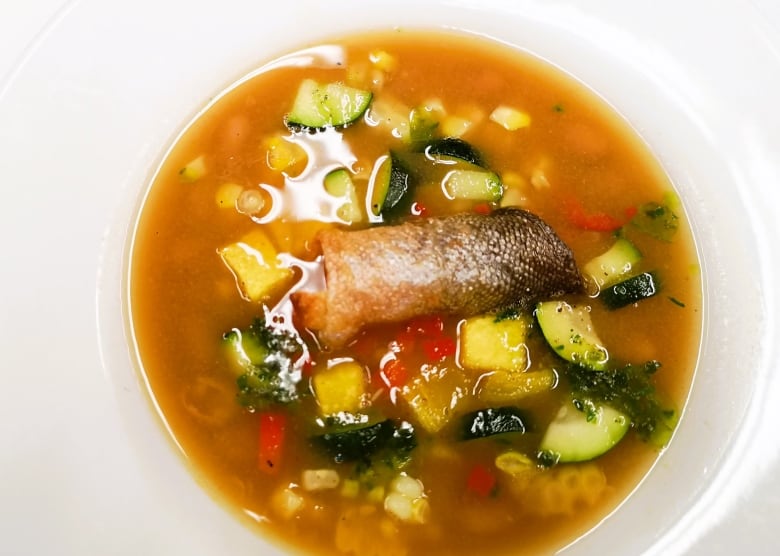This week, in a collaboration with Kitchener’s Best Toques culinary university, chef Destiny Moser served a 5-class supper applying two dozen elements that spanned cultures and also served as an educational medium for teaching Indigenous foods and cooking.
“We produced a menu concentrating on Indigenous components, but we wanted to make confident we were not far too significantly from the recipes and dishes we’re acquainted with,” explained Moser.
That integrated bannock, an ostensibly Indigenous flat bread which was ordinarily cooked on sizzling stones.
A graduate of Top rated Toques and Position To start with Country as part of the Ojibwe tribe of the Rainy River Band, Moser says bannock is acquainted to numerous individuals, but it “weighs in” substantially on Fact and Reconciliation as a dish that a lot of presume is Indigenous.
“It’s an instructional option. I like to level out that bannock is actually Scottish,” she said.

Fairly, Indigenous people ended up forced to study how to make it by the settlers when they had been pressured off the land and missing entry to their regular food stuff resources.
Leading Toques chef-instructors Dean Michielsen, Darryl Howie and Elaina Kourie and teams of students labored above two days to put together bannock and the other components of the dinner.
The menu highlighted legendary, and delightful, Three Sisters soup with its trio of corn, beans and squash, which customarily are grown jointly. Corn stalks offer construction for the beans to climb, though mature squash leaves shelter the root place impeding weed expansion and moderating temperature. The beans nourish the soil with nitrogen.
Moser, whose mom was born as component of the Rainy River tribe and was also a part of the Sixties Scoop, has utilized Indigenous foods and cooking to emphasize and advocate for Indigenous lifestyle in Waterloo Region when she visits area superior universities.
Her duck confit main course blended French system with a 36-hour sous vide that Moser and the kitchen area employed to replicate the very long braise that early Indigenous cooks would have utilized.

She noted that the sous vide and the further confit unwanted fat would not have been used by early Indigenous cooks, but fairly a long, slow cook in excess of fire which generated very similar final results to the Gascony, France dish. The ensuing duck was extremely tender and prosperous.
Also on the menu was seasonal smoked Arctic char, pumpkin, sage, wheat berries, cranberries and verjus (an ancient ingredient made from the juice of unripened grapes).
Wild rice, “manoomin” in Anishinaabe, is a sacred component for Indigenous cultures, and a person that has a unique position in this state. Moser mentioned that of 4 wild rice species – truly an aquatic grass – three are indigenous to Canada and is its only indigenous grain. Corn, while plentiful listed here, was initially domesticated by the Indigenous peoples of southern Mexico.
As soon as ubiquitous all-around the Wonderful Lakes, wild rice lends its name to Rice Lake in the Trent-Severn Waterway and other geographical capabilities offered the abundant crops that the moment grew there.
But like many species, its habitat has been substantially decreased making it scarce and under danger for survival. Wild rice thrives in a weather with severe winters, but scientists wonder if local climate improve and far more moderate winters could influence in which it can increase sustainably.

Moser mentioned the nutty excellent of grains and how the college students she prepares it for really like the wild rice and pumpkin salad created with sunflower oil, instead than olive oil.
“I make this dish for learners I instruct about Indigenous cooking, and they adore it. And most likely because it has a sweetness.”
Final year, Moser visited Waterloo Location District School Board substantial faculties with the Ontario Youth Apprenticeship Software group to do palms-on cooking workshops about Indigenous foods and her personal private path to getting to be a chef.
Acquiring been active in the local community demonstrating and talking on behalf of Indigenous cooking for quite a few yrs now, Moser reported she has found enhancements in people’s comprehension of Indigenous foodways, each regionally and internationally.
She attended the sixth yearly conference on Indigenous American Nourishment in Minnesota earlier this month. The topic was Resurgence of Indigenous Foodways, and she stated she uncovered how diet program – and specifically Indigenous eating plans – influence health.

She pointed out that just before settlers, Indigenous people today did not have diabetic issues, but considering that currently being launched to flour, sugar and other processed foodstuff, the Indigenous population of Canada is the greatest populace with the condition.
“At the meeting, they observed related patterns with other Indigenous communities all over the planet. Researchers, medical professionals and nutritionists are getting that a whole lot of these health conditions that we have now like diabetic issues, coronary heart disorder and cancers are driven in element by the foods we place in our diet regime. We have a lot of processed food items, and it can be also how we’re farming,” Moser explained.
Her intention has been to advocate for a return to classic Indigenous components, cooking and foodways.
Moser claimed she sees advancement in knowing closer to property, way too, such as much more Indigenous food items staying developed in local community gardens and a lot more consideration compensated to the topic at her alma mater, Leading Toques, from which she graduated a number of many years ago.
“At that time, when we obtained to environment cuisines, at no level did we talk about Indigenous food stuff. I’m incredibly prideful that now the faculty consistently retains me involved and figuring out how we can integrate Indigenous cuisine in teaching as they go ahead with new pupils.”